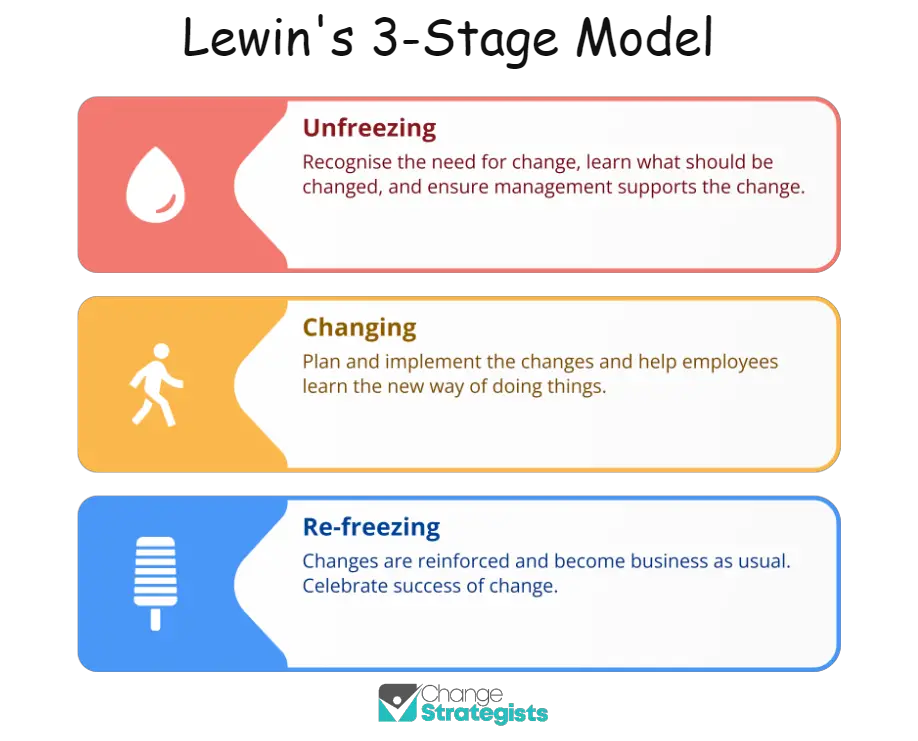Are you facing a daunting challenge of implementing change in your organization? Do you feel like you’re pushing a boulder uphill, with no end in sight? Fear not, for the Lewin’s Change Management Model is here to help you.
This powerful framework can help you navigate the treacherous waters of organizational change with ease and grace. The Lewin’s Change Management Model is like a trusted compass that helps you navigate through uncharted territory.
It provides you with a roadmap that helps you assess the current state of your organization, create a vision for the future state, and implement change through small, manageable steps. By following this model, you can ensure that your change initiative is successful, sustainable, and impactful.
So, let’s dive in and learn how to successfully implement the Lewin’s Change Management Model.
Understanding the Lewin’s Change Management Model
You’ll learn about the key concepts of the Lewin’s Change Management Model, which is a popular method for making organizational adjustments. This model is made up of three stages: unfreezing, changing, and refreezing.
In the unfreezing stage, individuals or groups are prepared for change by understanding the need for change and the benefits of it. In the changing stage, change is implemented and individuals or groups adjust to the new way of doing things. In the refreezing stage, the change is cemented in place and becomes a part of the organization’s culture.
Key principles of the Lewin’s Change Management Model include the importance of planning and communication. Planning involves identifying the need for change, setting goals, and creating a plan to achieve those goals. Communication is essential to ensure that everyone is on the same page and understands their role in the change process.
Practical applications of this model include implementing a new technology system, restructuring an organization, or changing the way a product is marketed.
Benefits of using the Lewin’s Change Management Model include a structured approach to change, increased employee engagement and buy-in, and a higher chance of success. However, there are also limitations to consider, such as resistance to change from employees or external factors that may affect the implementation process.
Overall, understanding the key concepts and principles of the Lewin’s Change Management Model can help organizations successfully implement change and improve their overall performance.
Assessing the Current State of Your Organization
Before diving into the process of Lewin’s change management approach, it’s important to take stock of your organization’s current state of affairs and identify any potential roadblocks that may arise down the line.
Conducting an organizational analysis is crucial to understanding the inner workings of your company, recognizing areas that need improvement, and identifying gaps that need to be filled. Here are four steps to help you conduct an effective organizational analysis:
1. Identify the goals of your organization: Knowing what your company stands for and what it aims to achieve is critical to assessing its current state. Are your goals clearly defined? Are they still relevant?
It’s essential to ensure that your goals align with your company’s current vision and mission.
2. Assess the current structure: Take a closer look at your organization’s structure. Are there any communication barriers? Are there any redundancies in roles and responsibilities?
Identifying and addressing these issues can help streamline processes and improve efficiency.
3. Analyze your workforce: Understanding your workforce is key to identifying gaps in skills, knowledge, and training. Are your employees properly trained for their roles? Are there areas where additional training can help improve productivity?
It’s important to assess the current state of your workforce to determine how to best support them through the change process.
4. Evaluate your current systems and processes: Analyze your current systems and processes to identify any shortcomings. Are they effective and efficient? Are they outdated?
Identifying areas where improvements can be made will help you determine what changes need to be made to support the change process.
Conducting an effective organizational analysis is essential to implementing Lewin’s change management model successfully. By identifying potential roadblocks and filling in gaps, you can better prepare your organization for the change process. Remember, the key to success is in understanding the current state of your organization and identifying areas where improvements can be made.
Creating a Vision for the Future State
Let’s create a vision for the future that inspires and motivates your organization to embrace positive change and achieve greatness. Developing buy-in from your team is essential in this step. Get them involved, and ask for their input. After all, they’re the ones who’ll be implementing the changes.
Build a shared vision that aligns with your organization’s goals and values. Make sure it’s clear, concise, and achievable.
Communicating effectively is crucial in getting everyone on board with the vision. Share the vision with your team, and explain how it’ll benefit the organization. Provide examples of how the changes will improve productivity, customer satisfaction, and overall success. Be transparent and honest about the challenges that may arise during the change process. Encourage feedback and questions from your team, and address any concerns they may have.
Creating a vision for the future state is an exciting step in the change management process. It sets the tone for the rest of the project and ensures everyone is working towards the same goal. Remember to involve your team, communicate effectively, and build a shared vision that inspires and motivates everyone involved. With a clear vision and a committed team, your organization can achieve greatness.
Implementing Change through Small Steps
As you begin taking small steps towards implementing change, you’ll find that progress may come gradually but consistently, ultimately leading to a successful transformation of your organization.
Breaking down the change into smaller, manageable steps can help your employees understand the process and feel more comfortable with the transition. It’s important to communicate the changes transparently and regularly to keep everyone informed and engaged.
Employee engagement is crucial in implementing change through small steps. Your employees are the ones who will be experiencing the changes firsthand, so it’s important to involve them in the process and make them feel like their input is valued. This can be done through regular feedback sessions, town hall meetings, and other communication channels.
By empowering your employees to take ownership of the change, you’ll create a culture of accountability and collaboration.
Taking small steps towards change can be a powerful approach that yields big results. By breaking down the change into manageable chunks and engaging your employees throughout the process, you’ll create a culture of continuous improvement.
Remember that change is a journey, not a destination. Stay committed to the process, and celebrate each milestone along the way. With perseverance and dedication, you’ll achieve your vision for a transformed organization.
Sustaining Change for Long-Term Success
Maintaining lasting change is like tending a garden, requiring ongoing care and attention to ensure growth and sustainability. Even with the successful implementation of the Lewin’s Change Management Model, it’s crucial to sustain the changes for long-term success.
One of the main reasons for change failure is change resistance, where employees may struggle to adjust to new processes, technologies, or attitudes. To overcome change resistance, it’s essential to communicate the benefits of the change and involve employees in the process. Providing training and support to employees during the transition period can also help them adapt to new ways of working.
Additionally, leadership support is crucial in sustaining change, as leaders can motivate and encourage employees to embrace the changes and continue to work towards the common goal. Incorporating regular check-ins and evaluations can also help ensure that the changes are effective and sustainable in the long run.
Leaders should monitor progress and continuously gather feedback to identify areas for improvement and make necessary adjustments. By doing so, they can maintain employee engagement and commitment towards the change, ultimately leading to long-term success.
What Role Does the Lewins Change Management Model Play in Building a Successful Change Management Team?
The Lewins Change Management Model plays a crucial role in building a successful change management team. By focusing on driving change through three key stages – unfreezing, changing, and refreezing – this model provides a structured approach for building successful change management teams to navigate organizational transitions effectively.
Conclusion
Congratulations! You’ve successfully learned how to implement Lewin’s Change Management Model in your organization. By understanding the three stages of change – unfreeze, change, and refreeze – you were able to assess the current state of your organization, create a vision for the future state, and implement change through small steps.
Remember, change is a process and it takes time. Just like a seed needs nurturing to grow into a beautiful flower, change needs patience, commitment, and hard work to yield positive results. It may not be easy, but it’s worth it.
Implementing Lewin’s Change Management Model is like embarking on a journey. You need to be prepared, have a clear destination in mind, and take small steps towards your goal.
It may be challenging at times, but like a hiker reaching the summit of a mountain, the sense of accomplishment and satisfaction you’ll feel when you reach your destination will be worth the effort.
So go ahead, take the first step towards change, and see your organization thrive!





